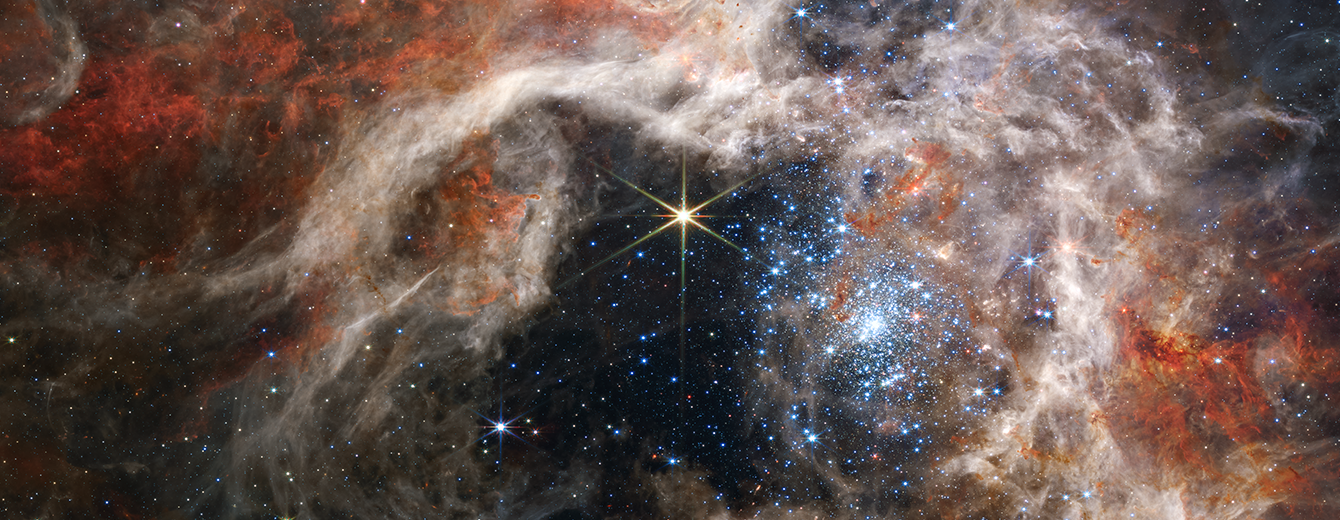International
NASA’s Webb catches Tarantula Nebula

AFP
A stellar nursery nicknamed the Tarantula Nebula has been captured in crisp detail by NASA’s Webb telescope, revealing hitherto unseen features that deepen scientific understanding, the agency said Tuesday.
Officially known as 30 Doradus, the region of space is characterized by its dusty filaments that resemble the legs of a hairy spider, and has long been a favorite for astronomers interested in star formation.
Thousands of young stars, distant background galaxies, and the detailed structure of the nebula’s gas and dust structures were viewable for the first time thanks to Webb’s high resolution infrared instruments.
Webb operates primarily in the infrared spectrum, because light from objects in the distant cosmos has been stretched into this wavelength over the course of the universe’s expansion.
The telescope’s primary imager, Near-Infrared Camera (NIRCam), found the cavity in the center of the nebula was hollowed out by radiation carried on stellar winds emanating from a cluster of massive young stars, which appear as pale blue dots.
Webb’s Near-Infrared Spectrograph (NIRSpec), which analyzes light patterns to determine the composition of objects, caught one young star in the act of shedding a cloud of dust from around itself.
The same star was previously thought to be at a later stage of formation, already well on the way to clearing its dusty bubble.
The region was also imaged using the Mid-infrared Instrument (MIRI), which uses longer wavelengths of infrared to pierce through dust grains that absorb or scatter shorter wavelengths.
This faded the hot stars and clarified the cooler regions, revealing never-before-seen points of light within the stellar nursery, which indicate protostars that are still gaining mass.
Astronomic interest in the Tarantula Nebula stems from its similar chemical composition to gigantic star-forming regions observed a few billion years after the Big Bang, a period called the “cosmic noon” when star formation peaked.
At just 161,000 light-years away, Tarantula is a readily viewable example of this flourishing period of cosmic creation.
Webb should also provide scientists the opportunity to gaze at distant galaxies from the actual era of cosmic noon, and compare it to observations of Tarantula, to understand similarities and differences.
Operational since July, Webb is the most powerful space telescope ever built, with astronomers confident it will herald a new era of discovery.
International
Climate-driven rains trigger one of Indonesia’s deadliest flood emergencies in years

A torrential monsoon season, compounded by two unusual tropical cyclones, has triggered intense rainfall in several regions since last week, including southern Thailand, northern Malaysia, and large parts of Indonesia.
Climate change has recently intensified rainfall patterns, as a warmer atmosphere is able to hold more moisture. In Indonesia, desperation is growing among those affected by the disaster due to the slow pace of rescue operations and the distribution of humanitarian aid.
Relief agencies warned that the scale of the emergency is nearly unprecedented, even for a country accustomed to frequent natural disasters.
Across the island of Sumatra, the death toll was revised downward to 770 fatalities and at least 463 people still missing as of Wednesday night. Earlier, the national disaster management agency had reported 804 deaths.
Gathering accurate information on the ground remains difficult, as many regions are still cut off due to flood damage, widespread power outages, communication failures, or a combination of all three.
International
Russian authorities ban Roblox citing child safety and moral concerns

Russia has blocked access to the U.S.-owned game creation platform Roblox, accusing it of distributing extremist materials and what authorities described as “LGBT propaganda,” state media reported on Wednesday.
The country has repeatedly threatened to ban certain foreign digital platforms, a move that human rights organizations view as part of broader efforts by authorities to tighten control over internet use.
In a statement released through Russian news agencies, the federal communications watchdog Roskomnadzor accused Roblox of hosting “inappropriate content that can negatively affect the spiritual and moral development of children.”
“The game exposes minors to sexual harassment, tricks them into sharing intimate photos, and encourages them to commit acts of depravity and violence,” the regulator claimed.
Last week, the same agency also threatened to ban WhatsApp, the country’s second most widely used messaging app, accusing it of failing to prevent criminal activity.
Roblox, which is owned by the U.S.-based Roblox Corporation, did not immediately respond to a request for comment.
According to company data for 2024, the platform has around 100 million daily users worldwide, nearly 40% of whom are under the age of 13.
Other countries, including Qatar, Iraq and Turkey, have also restricted or banned Roblox, mainly over concerns about the safety of underage users. In the United States, the states of Texas and Louisiana have filed lawsuits against the platform on similar grounds.
International
El Chapo’s son Joaquín Guzmán López pleads guilty to U.S. drug trafficking charges

Joaquín Guzmán López, one of the sons of notorious Mexican drug lord Joaquín “El Chapo” Guzmán, pleaded guilty on Monday to drug trafficking charges in a U.S. court, months after his brother Ovidio reached a similar plea agreement, according to local media reports.
The defendant appeared before a federal court in Chicago early Monday afternoon and changed his previous plea in the case, the Chicago Tribune reported. U.S. authorities accuse him of forming, together with his three brothers, the cartel faction known as “Los Chapitos.”
The group is believed to have continued the operations of El Chapo, who has been serving a life sentence in the United States since 2019.
Guzmán López, 39, was arrested after landing in Texas in a small aircraft alongside cartel co-founder Ismael “El Mayo” Zambada.
-

 Central America4 days ago
Central America4 days agoHonduras’ China–Taiwan Future Hinges on Sunday’s Presidential Election
-

 Central America3 days ago
Central America3 days agoHonduras Extends Voting by One Hour Amid High Turnout, CNE Announces
-

 International3 days ago
International3 days agoHong Kong police arrest 13 over deadly high-rise fire that killed 151
-

 International3 days ago
International3 days agoSri Lanka and Indonesia deploy military as deadly asian floods kill over 1,000
-

 International3 days ago
International3 days agoTrump says asylum decision freeze will remain in place “for a long time”
-

 International3 days ago
International3 days agoChile enters runoff campaign with Kast leading and Jara seeking a last-minute comeback
-

 International2 days ago
International2 days agoVenezuela authorizes return flights as U.S. continues deportations amid rising tensions
-

 International2 days ago
International2 days ago20,000 rounds stolen from german army after driver leaves cargo unattended
-

 International2 days ago
International2 days agoEl Chapo’s son Joaquín Guzmán López pleads guilty to U.S. drug trafficking charges
-

 International13 hours ago
International13 hours agoRussian authorities ban Roblox citing child safety and moral concerns
-

 International2 days ago
International2 days agoTrump convenes National Security Council as U.S.–Venezuela tensions intensify
-

 Sin categoría12 hours ago
Sin categoría12 hours agoJuan Orlando Hernández’s family takes time to decide next steps after surprise U.S. release
-

 International13 hours ago
International13 hours agoClimate-driven rains trigger one of Indonesia’s deadliest flood emergencies in years






























